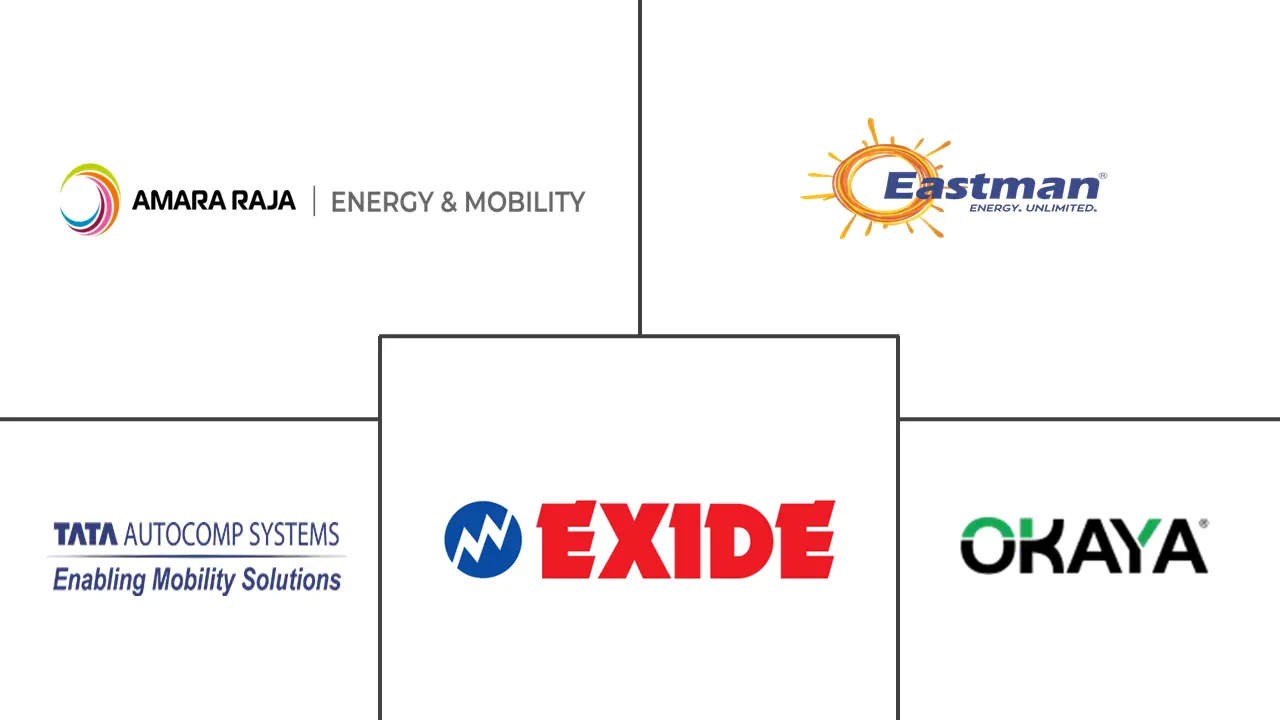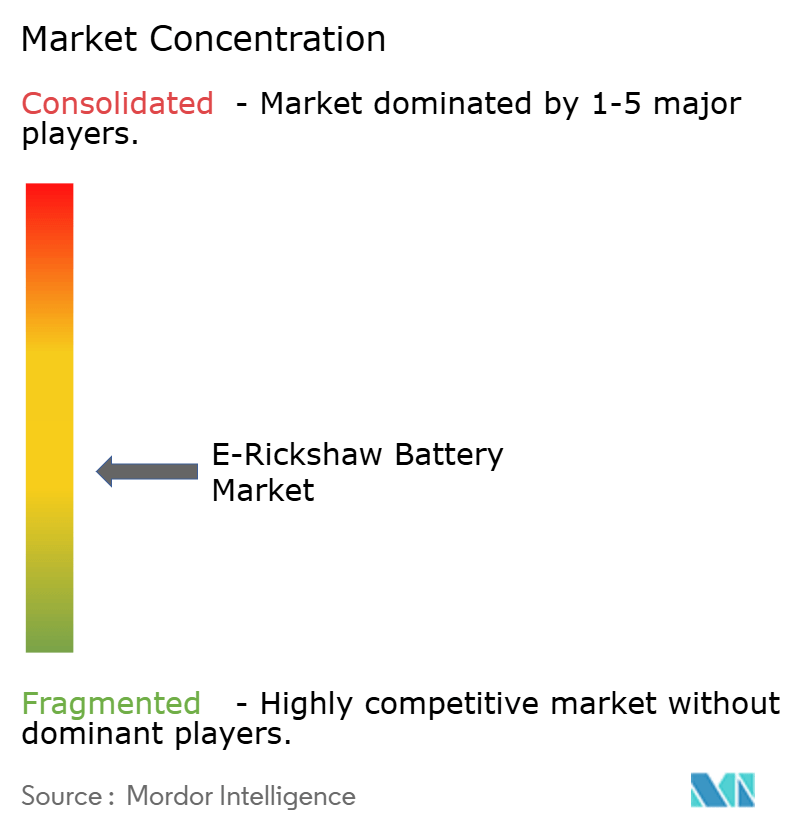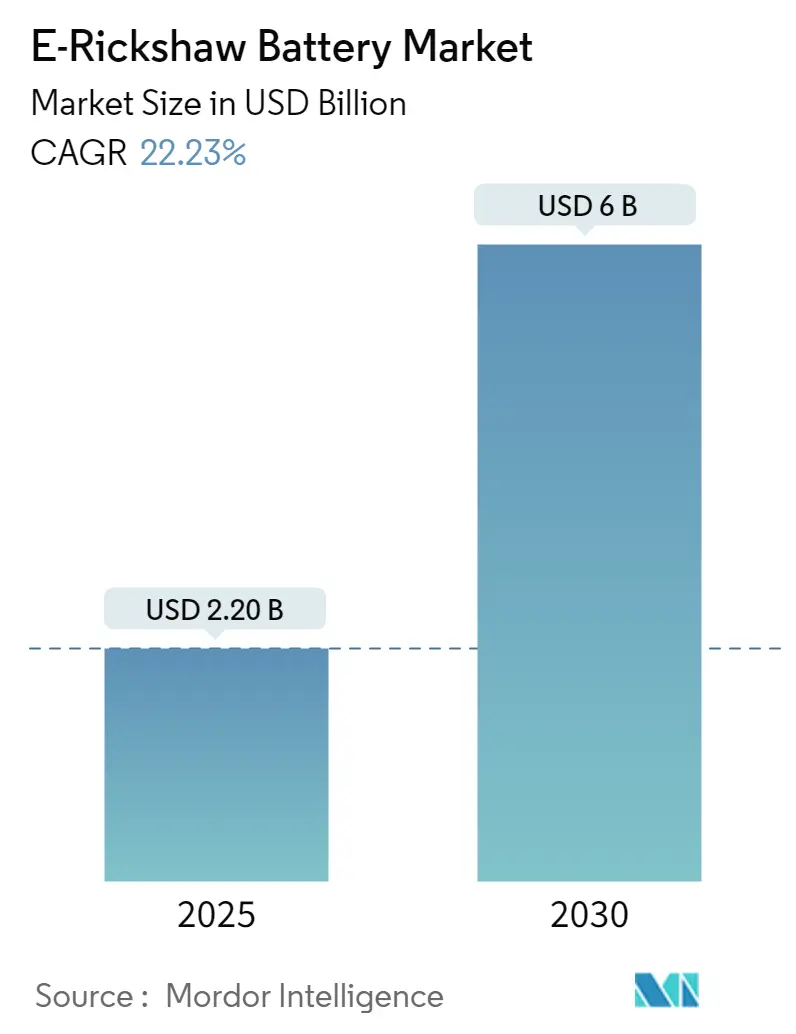
E-Rickshaw Battery Market Analysis
The E-Rickshaw Battery Market size is estimated at USD 2.20 billion in 2025, and is expected to reach USD 6.00 billion by 2030, at a CAGR of 22.23% during the forecast period (2025-2030).
- Over the medium term, the growing adoption of e-rickshaws aided by government initiatives and the lower operational and maintenance costs compared to traditional fossil fuel-powered rickshaws are expected to drive the e-rickshaw battery market during the forecast period.
- On the other hand, the lack of widespread and accessible charging infrastructure and the limited range of e-rickshaws can hinder the growth of the e-rickshaw battery market during the forecast period.
- Ongoing advancements in battery technologies, such as increased energy density and the implementation of battery-swapping infrastructure for e-rickshaw, are likely to create vast opportunities for the e-rickshaw battery market.
- Asia-Pacific is expected to be a dominant region in the e-rickshaw market due to the increasing adoption of battery-powered vehicles.
E-Rickshaw Battery Market Trends
Lithium-ion Battery to be the Fastest Growing
- Among different types of battery technologies, lithium-ion batteries (LIB) are expected to be among the fastest-growing e-rickshaw battery markets during the forecast period. Lithium-ion batteries are gaining more popularity than other battery types due to their favorable capacity-to-weight ratio. Other factors boosting their adoption include better performance (long and low maintenance), better shelf life, and decreasing price.
- Lithium-ion (Li-ion) batteries offer various technical advantages over other technologies, such as lead-acid batteries. On average, Li-ion batteries offer cycles over 5,000 times compared to lead-acid batteries that last around 400-500 times. Li-ion batteries do not require as frequent maintenance and replacement as lead-acid batteries. Furthermore, these batteries maintain their voltage throughout the discharge cycle, allowing more significant and longer-lasting efficiency of electrical components.
- In recent years, several major lithium-ion battery players have been investing to gain economies of scale and R&D activities to enhance their performance, increasing the competition and declining lithium-ion battery prices. For example, due to the improving technological innovations, manufacturing improvements, and declining raw material costs, the volume-weighted average price of lithium-ion batteries decreased considerably from USD 780/kWh in 2013 to USD 139/kWh in 2023. It is likely to reach around USD 113/kWh in 2025 and USD 80/kWh in 2030. Such declining trends in battery costs are likely to make it a lucrative choice among all batteries for the e-rickshaw battery market in the coming years.
- Lithium-ion batteries have traditionally been used in consumer electronic devices like mobile phones, laptops, and others. However, in recent years, they have increasingly been redesigned for use as the power source of choice in electric vehicles (BEVs), including e-rickshaws, in various countries, owing to factors such as low environmental impact.
- In December 2023, South Korea's Ministry of Finance announced plans to provide KRW 38 trillion in policy financing to the lithium battery industry over the next five years. This policy will be formally implemented in 2024. South Korea also plans to establish a KRW 1 trillion lithium battery industry promotion fund and invest KRW 73.6 billion in research and development of related technologies. At the same time, the government decided to increase the critical mineral reserves required for domestic lithium battery manufacturing and cultivate a battery reuse and recycling ecosystem. All these are anticipated to boost the lithium-ion battery industry and, in turn, support the growth of the e-rickshaw batteries market.
- There has been an increasing trend in lithium-ion battery manufacturing in the Asia-Pacific region. For example, in March 2024, Panasonic Group announced it would form a joint venture with Indian Oil Corporation Ltd (IOCL) to manufacture cylindrical lithium-ion batteries. Panasonic Energy, a group firm, signed a binding term sheet and initiated discussions with IOCL to draw a framework for forming a joint venture to manufacture cylindrical lithium-ion batteries. This initiative is driven by the expected expansion of demand for batteries for two and three-wheel vehicles in the Indian market.
- In May 2023, Stellantis, together with TotalEnergies and Mercedes-Benz, celebrated the inauguration of Automotive Cells Company's (ACC) battery gigafactory in Billy-Berclau Douvrin, France, the first of three planned in Europe. With an initial production line capacity of 13 gigawatt-hours (GWh), rising to 40 GWh by 2030, the facility is expected to deliver high-performance lithium-ion batteries with a minimal CO2 footprint. The gigafactory will contribute to Stellantis' goal of increasing battery manufacturing capacity to 250 GWh in Europe by 2030.
- Furthermore, as per the Office of Energy Efficiency and Renewable Energy, in 2023, the government announced the development of electric vehicle battery plants in North America. The region is expected to ramp up manufacturing capacity from 55 gigawatts per year (GWh/year) in 2021 to 1000 GWh/year by 2030. Most of the projects in the pipeline are expected to initiate production between the years 2025 to 2030. This indicates a robust battery market development for automotive applications, which is expected to support the e-rickshaw battery market in the coming years.
- In January 2024, Panasonic Energy announced an update on their USD 4 billion electric vehicle battery plant, still under construction, in De Soto, Kansas. According to the company, the manufacturing facility will produce 66 lithium-ion batteries per second when operating at full capacity. The 4.7 million-square-foot battery plant is still under construction on the former Sunflower Army Ammunition Plant site, and it is expected to begin production in March 2025. Such developments in lithium-ion batteries are anticipated to continue across the globe and support the e-rickshaw battery market.
- Due to properties such as less weight, low charging time, a higher number of charging cycles, declining cost, and the growing progress in lithium-ion batteries, they are likely to be the fastest-growing battery type among electric vehicles, including the e-rickshaw battery market, during the forecast period.
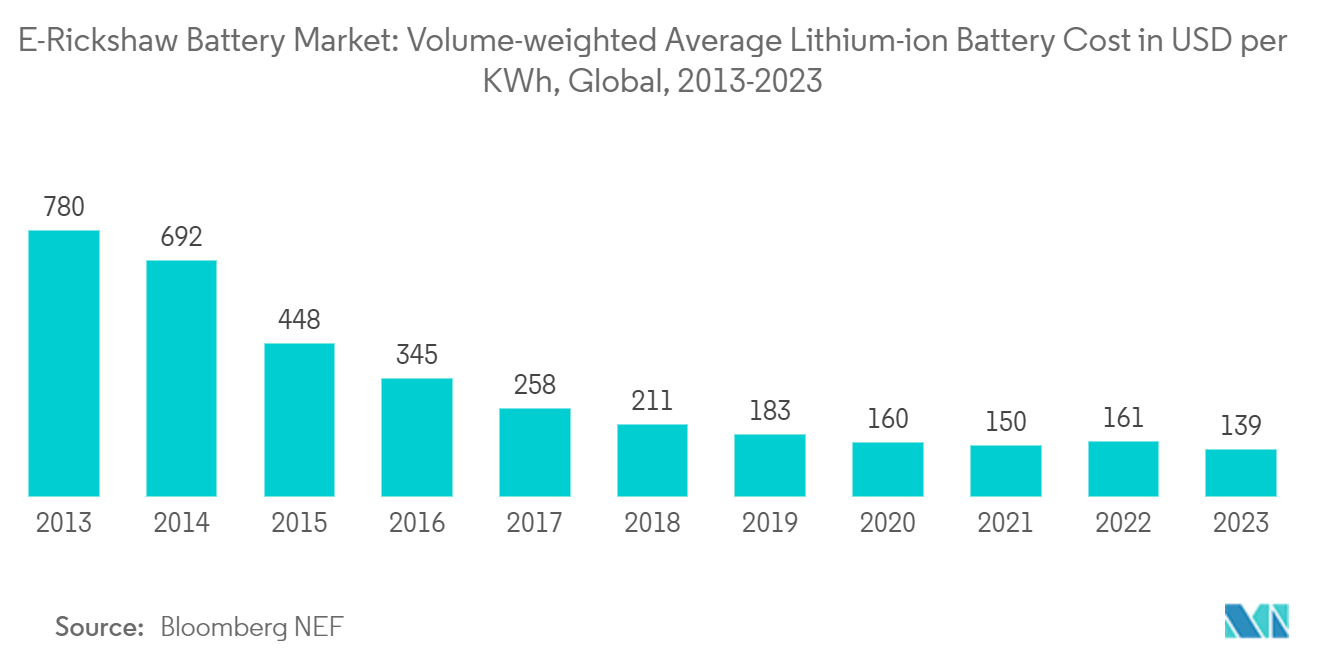
Asia-Pacific Region is Expected to Dominate the Market
- The Asia-Pacific region is anticipated to dominate the e-rickshaw battery market during the forecast period due to several compelling factors. For example, the high population density and rapid urbanization in countries such as India, China, and Bangladesh are driving the need for efficient and affordable transportation solutions, positioning e-rickshaws as a preferred option for short-distance travel. This high demand directly translates to a robust market for e-rickshaw batteries.
- Various emerging countries in the region are experiencing notable government support for the adoption of e-rickshaws. In particular, countries such as India are implementing supportive regulations, subsidies, and incentives to promote the adoption of electric vehicles, including e-rickshaws, as part of broader efforts to combat pollution and reduce dependency on fossil fuels. For instance, India's Faster Adoption and Manufacturing of Hybrid and Electric Vehicles (FAME) scheme significantly incentivized the adoption of electric vehicles, including e-rickshaws.
- In March 2024, the Ministry of Heavy Industries (MHI) in India launched the Electric Mobility Promotion Scheme (EMPS) that aims to boost the adoption of two-wheeler and three-wheeler electric vehicles for commercial purposes and provide the necessary support for developing and manufacturing EVs in India.
- The EMPS-2024 is being implemented for four months, from 1 April 2024 to 31 July 2024. It has a budget of INR 500 crore and provides subsidies to EVs. Subsidies of up to INR 10,000 will be provided for each two-wheeler EV, up to INR 25,000 for each small three-wheeler EV, and up to INR 50,000 for each large three-wheeler EV. The MHI will reimburse the subsidies or demand incentives to the EV manufacturers upon the sale of a vehicle, which will also benefit the consumers as the subsidy amount will be deducted from the final invoice price, thus reducing the purchase price of the EVs. Such initiatives are anticipated to boost the country's adoption of e-rickshaws and their relevant batteries.
- As per the Ministry of Road Transport and Highways in India, the annual sales of electric three-wheelers in India stood at over 581 thousand units in 2023. The data from the International Energy Agency (IEA) revealed that together, China and India accounted for 66% of the world's electric three-wheeler sales share in 2023. This highlights that these countries are likely to continue and witness vast growth during the forecast period.
- Moreover, crucial battery manufacturers in the region enhance the market’s growth. Companies like Exide Industries, Amara Raja Batteries, and Okaya Power offer easy access to the latest battery technologies and innovations. Besides, these players continuously invest in research and development to improve battery performance, reduce costs, and extend the lifespan of e-rickshaw batteries, making them more attractive to consumers.
- The Asia-Pacific region benefits from lower production costs due to cheaper labor and raw materials, enabling competitive pricing of e-rickshaw batteries. This cost advantage helps drive widespread adoption across different socioeconomic segments, making e-rickshaws an economically viable solution for many.
- Furthermore, the rising environmental awareness and the need for sustainable urban transport solutions propel the market forward. E-rickshaws offer a greener alternative to traditional auto-rickshaws, aligning with the environmental goals of many Asia-Pacific nations. As a result, the region is expected to maintain its leading position in the global e-rickshaw battery market for the foreseeable future.
- Therefore, due to the abovementioned factors, the Asia-Pacific region is expected to dominate the e-rickshaw market during the forecast period.
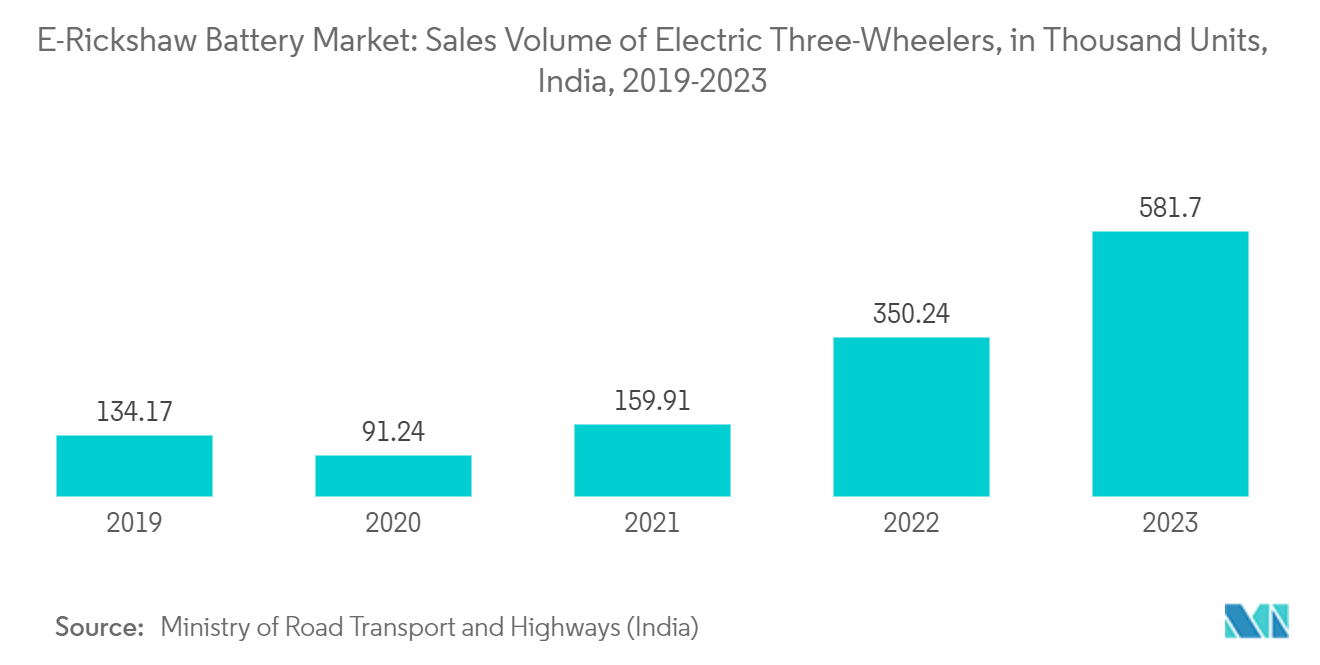
E-Rickshaw Battery Industry Overview
The e-rickshaw battery market is semi-fragmented. Some key players in the market (not in any particular order) include Exide Industries Ltd, Eastman Auto & Power Ltd, Amara Raja Energy & Mobility Limited, Okaya Power Private Limited, and TATA AutoComp GY Batteries Pvt. Ltd.
E-Rickshaw Battery Market Leaders
-
Exide Industries Ltd
-
Eastman Auto & Power Ltd
-
Amara Raja Energy & Mobility Limited
-
TATA AutoComp GY Batteries Pvt. Ltd.
-
Okaya Power Private Limited
- *Disclaimer: Major Players sorted in no particular order
E-Rickshaw Battery Market News
- May 2024: Piaggio announced plans to offer a battery subscription model for Ape Electric 3W at USD 3100 thousand. The company's new Battery Subscription Model will make three-wheeler EV ownership even more attractive. The battery subscription model strives to revolutionize three-wheeler ownership with more affordability by separating the upfront cost of the vehicle from the cost of the battery.
- September 2023: Mahindra, a leading e3-wheeler manufacturer in India, announced plans to introduce the EALFA Super Rickshaw. This innovative vehicle boasts an enhanced range to improve the overall performance and efficiency of last-mile connectivity solutions. The EALFA Super Rickshaw has been designed to meet customers' evolving needs, ensuring a comfortable and reliable ride. Mahindra's commitment to sustainability and advanced technology continues to drive its success in the e3-wheeler market.
E-Rickshaw Battery Industry Segmentation
An e-rickshaw battery is a power storage device specifically designed to supply electric energy to e-rickshaws, three-wheeled electric vehicles used primarily for short-distance public transportation. These batteries, typically available in lead-acid and lithium-ion variants, provide the necessary energy to drive the electric motor, enabling the e-rickshaw to operate efficiently. Key attributes of these batteries include their capacity, charging time, lifespan, and cost, all of which significantly impact the performance, range, and overall economic viability of the e-rickshaw.
The e-rickshaw battery market is segmented into battery type, vehicle type, and geography. By battery type, the market is segmented into lead-acid battery, lithium-ion battery, and other batteries. By vehicle type, the market is segmented into passenger carrier and goods carrier. The report also covers the market size and forecasts for the e-rickshaw battery market across major regions. The report offers value terms in USD for the abovementioned segments.
| Battery Type | Lead-acid Battery | ||
| Lithium-ion Battery | |||
| Other Batteries | |||
| Vehicle Type | Passenger Carrier | ||
| Goods Carrier | |||
| Geography | North America | United States | |
| Canada | |||
| Rest of North America | |||
| Europe | Germany | ||
| United Kingdom | |||
| France | |||
| Italy | |||
| Spain | |||
| Nordic | |||
| Russia | |||
| Rest of Europe | |||
| Asia-Pacific | China | ||
| India | |||
| Japan | |||
| South Korea | |||
| Thailand | |||
| Malaysia | |||
| Indonesia | |||
| Vietnam | |||
| Rest of Asia-Pacific | |||
| Middle East and Africa | Saudi Arabia | ||
| United Arab Emirates | |||
| South Africa | |||
| Egypt | |||
| Nigeria | |||
| Qatar | |||
| Rest of Middle East and Africa | |||
| South America | Brazil | ||
| Argentina | |||
| Chile | |||
| Rest of South America | |||
E-Rickshaw Battery Market Research Faqs
How big is the E-Rickshaw Battery Market?
The E-Rickshaw Battery Market size is expected to reach USD 2.20 billion in 2025 and grow at a CAGR of 22.23% to reach USD 6 billion by 2030.
What is the current E-Rickshaw Battery Market size?
In 2025, the E-Rickshaw Battery Market size is expected to reach USD 2.20 billion.
Who are the key players in E-Rickshaw Battery Market?
Exide Industries Ltd, Eastman Auto & Power Ltd, Amara Raja Energy & Mobility Limited, TATA AutoComp GY Batteries Pvt. Ltd. and Okaya Power Private Limited are the major companies operating in the E-Rickshaw Battery Market.
Which is the fastest growing region in E-Rickshaw Battery Market?
Asia Pacific is estimated to grow at the highest CAGR over the forecast period (2025-2030).
Which region has the biggest share in E-Rickshaw Battery Market?
In 2025, the Asia Pacific accounts for the largest market share in E-Rickshaw Battery Market.
What years does this E-Rickshaw Battery Market cover, and what was the market size in 2024?
In 2024, the E-Rickshaw Battery Market size was estimated at USD 1.71 billion. The report covers the E-Rickshaw Battery Market historical market size for years: 2019, 2020, 2021, 2022, 2023 and 2024. The report also forecasts the E-Rickshaw Battery Market size for years: 2025, 2026, 2027, 2028, 2029 and 2030.
E-Rickshaw Battery Industry Report
Statistics for the 2025 E-Rickshaw Battery market share, size and revenue growth rate, created by Mordor Intelligence™ Industry Reports. E-Rickshaw Battery analysis includes a market forecast outlook for 2025 to 2030 and historical overview. Get a sample of this industry analysis as a free report PDF download.

